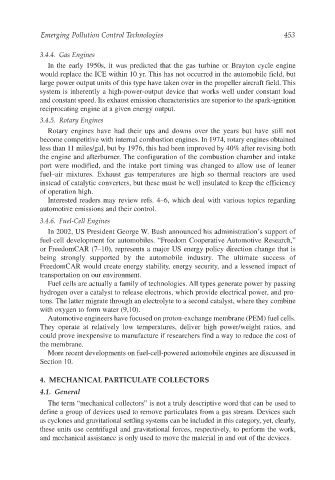Page 481 - Air Pollution Control Engineering
P. 481
12_ch_wang.qxd 05/05/2004 5:26 pm Page 453
Emerging Pollution Control Technologies 453
3.4.4. Gas Engines
In the early 1950s, it was predicted that the gas turbine or Brayton cycle engine
would replace the ICE within 10 yr. This has not occurred in the automobile field, but
large power output units of this type have taken over in the propeller aircraft field. This
system is inherently a high-power-output device that works well under constant load
and constant speed. Its exhaust emission characteristics are superior to the spark-ignition
reciprocating engine at a given energy output.
3.4.5. Rotary Engines
Rotary engines have had their ups and downs over the years but have still not
become competitive with internal combustion engines. In 1974, rotary engines obtained
less than 11 miles/gal, but by 1976, this had been improved by 40% after revising both
the engine and afterburner. The configuration of the combustion chamber and intake
port were modified, and the intake port timing was changed to allow use of leaner
fuel–air mixtures. Exhaust gas temperatures are high so thermal reactors are used
instead of catalytic converters, but these must be well insulated to keep the efficiency
of operation high.
Interested readers may review refs. 4–6, which deal with various topics regarding
automotive emissions and their control.
3.4.6. Fuel-Cell Engines
In 2002, US President George W. Bush announced his administration’s support of
fuel-cell development for automobiles. “Freedom Cooperative Automotive Research,”
or FreedomCAR (7–10), represents a major US energy policy direction change that is
being strongly supported by the automobile industry. The ultimate success of
FreedomCAR would create energy stability, energy security, and a lessened impact of
transportation on our environment.
Fuel cells are actually a family of technologies. All types generate power by passing
hydrogen over a catalyst to release electrons, which provide electrical power, and pro-
tons. The latter migrate through an electrolyte to a second catalyst, where they combine
with oxygen to form water (9,10).
Automotive engineers have focused on proton-exchange membrane (PEM) fuel cells.
They operate at relatively low temperatures, deliver high power/weight ratios, and
could prove inexpensive to manufacture if researchers find a way to reduce the cost of
the membrane.
More recent developments on fuel-cell-powered automobile engines are discussed in
Section 10.
4. MECHANICAL PARTICULATE COLLECTORS
4.1. General
The term “mechanical collectors” is not a truly descriptive word that can be used to
define a group of devices used to remove particulates from a gas stream. Devices such
as cyclones and gravitational settling systems can be included in this category, yet, clearly,
these units use centrifugal and gravitational forces, respectively, to perform the work,
and mechanical assistance is only used to move the material in and out of the devices.

